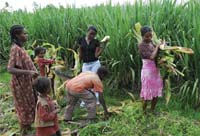19.4 The advantages of community mobilisation

There are several advantages of community mobilisation that will help local ownership and the sustainability of the health programmes. Community mobilisation helps to motivate the people in your community and encourages participation and involvement of everyone, as well as building community capacity to identify and address community needs (Figure 19.5). Community mobilisation also promotes sustainability and long-term commitment to a community change movement. In addition, it motivates communities to advocate for policy changes to respond better to their health needs.
Look back at the previous paragraph and make a list of what you think are the benefits of community mobilisation.
If the community owns its health activity, then this is more likely to be sustainable. By being involved they will also be empowered, partly by advocating for health policy changes.
Community mobilisation has several key steps (Box 19.1) and can come from the community itself, or may be initiated by outsiders. For instance, the community may request the local health workers to provide a health education session on malaria. This is an example that has been initiated by the community members. On the other hand, you may consider that female genital mutilation is a serious local problem and decide to mobilise the community to fight it. This is an example of community mobilisation initiated by others.
Box 19.1 Key steps in community mobilisation
- Create awareness of the health issue
- Motivate the community through community preparation, organisational development, capacity developments and bringing allies together
- Share information and communication
- Support them, provide incentives and generate resources.
There are many tools and techniques for collecting information that will help you to know more about your community. Here are some examples:
- Direct observation
- Group interviews
- Sketching maps
- Role-plays
- Stories
- Proverbs
- Workshops.
For example, to find out about the history of the community, you can create a ‘historic profile’. This allows you to become familiar with the history of the village chosen for community mobilisation. A village history will include the significance of its name, the people who founded it, and the major events that have marked it through time.
19.3 Equipping your community
